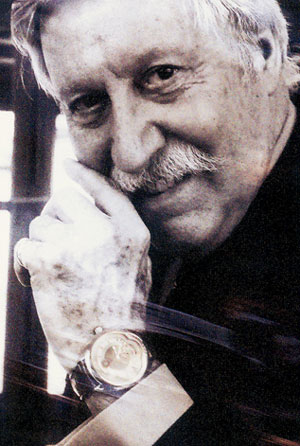Religion of Time and watch idols. Cult watch “Royal Oak” - Audemars Piguet (Part 1)
 In 1972, at the annual international In 1972, at the annual international watch exhibition BaselWorld in the small town of Basel, the company “Audemars Piguet” and designer Gerald Genta presented a watch set in the aggressive-steel case with deliberately rough finishing and huge octagonal bezel. The watch was destined to become the sensation of the exhibition that year and not just because its design was original and futuristic. An unusual, bold, avant-garde and monumental design of the watch was a completely new word in the watch design, so advanced that even after many years the connoisseurs and experts were still talking about it. watch exhibition BaselWorld in the small town of Basel, the company “Audemars Piguet” and designer Gerald Genta presented a watch set in the aggressive-steel case with deliberately rough finishing and huge octagonal bezel. The watch was destined to become the sensation of the exhibition that year and not just because its design was original and futuristic. An unusual, bold, avant-garde and monumental design of the watch was a completely new word in the watch design, so advanced that even after many years the connoisseurs and experts were still talking about it.
An octagonal shape of the case and bezel, which had no analogues, later became the trademark of Audemars Piguet: 38.7-mm case, tightly sealed throughout the entire thickness (8 mm) with eight hex head screws (innovative nut-octahedron). The case of presented watch looked like a solid safe. On the back side, large slotted nuts securely protected the movement from the elements. The second hand "disappeared" from the dial, and the hour and minute hands were performed with contours identical to markings of the dial. The bracelet was also original and new: it composed a whole unit with the case. The case, in fact, was the first link of the bracelet, smoothly tapering toward the clasp. The watch was made of principally new materials - brushed steel combined with the details of white gold (self-winding rotor and screws with hex heads) - and it worked on the basis of a new ultra-thin automatic caliber 2121, the thickness of which was only 3 mm - a unique phenomenon of its time. The watch “Royal Oak”, presented by Audemars Piguet and talented and original designer Gerald Genta, who designed that incredibly original and unique timepiece, is a watch that was destined to become a cult phenomenon in the watch world of the 70s and keep that title for many years.
Nevertheless, in 1972, the conservative Swiss public greeted the novelty cold enough, as it often happened with many innovative products. The company's management decided in disappointment to stop the production line, feeling sorry about the lost time on design and cooperation with Genta. And the batch of 1,000 copies was bought up by the Italians...
However... However, the history prepared an entirely different destiny. After a few months the company had to urgently resume the production line - the world demanded Royal Oak...
There were several reasons for such a resounding success: the very time and circumstances under which they appeared stipulated them. Among other things, the success looked absolutely fantastic on the background of the Swiss watch industry downturn and the global oil crisis.
As a result of this incredible story, Royal Oak is a symbol of the company's strength and stability in the world of watches. The name of the watch, in fact, has almost no connection with the watch or its movement. However, it is symbolic: the history of this name is rooted in the history of Misty Albion...
 Well, let's start from the name, Well, let's start from the name, skillfully linked with ancient and interesting legends. One of them tied the company “Audemars Piguet”, the King of England and old English oak together, becoming a forerunner of the famous watch line’s name. skillfully linked with ancient and interesting legends. One of them tied the company “Audemars Piguet”, the King of England and old English oak together, becoming a forerunner of the famous watch line’s name.
So, as the story goes, in 1651 the future King Charles II of England tried to escape from British troops, having lost the famous battle of Worcester - one of the decisive battles during the military campaign of Scotland conquest by Oliver Cromwell. The summer of 1651 begins with the capture of Scotland by British troops in south of Forth. Cromwell managed to bypass the Scottish troops located in Sterling area, led by David Leslie from the east, and enter Fife, after which the British managed to storm Perth, being in the rear of the Scots. Meanwhile, Charles II took the command of the Scottish army. Finding out that Cromwell had outflanked the Scottish army, thus opening a way to the south, Charles II directed the Scottish forces to England to raise new rebellions of the Royalist (a monarchical political movement of the government) and the Presbyterians (members of Protestant religion and a particular form of church organization based on the teachings of John Calvin).
However, to the great surprise of Charles, the Royalists or Presbyterians do not only hurry to join him, but as it turns out, the whole country comes out against him. Therefore, Charles has to abandon his original plan to go directly to London, and the future King goes to the valley of the Severn, and in August, 22, of 1651 his camp is located in Worcester.
In Worcester they decided to rest a few days and wait for a possible reinforcement from the Royalists of Worcestershire, Gloucestershire and Wales. However, the reinforcement remained negligible. Cromwell took advantage of Charles stop in Worcester, concentrating all his army and additional militias around the city. Charles II was aware of inevitability of the decisive battle and began constructing of additional fortifications in Worcester: on the southeast part of the city a new fort (Fort Royal) was built, defending the approaches to Worcester, and the bridges across the Severn were destroyed. Cromwell's army, in its turn, took the western shore of the Severn and began to position its artillery on the eastern hills. In August, 29, they started bombarding the city. In the morning on the 3rd of September, the English force under the command of General Fleetwood began to cross the river Tim, and Cromwell redirected the main forces from the other side of the Severn to help him. The first blow fell on the left flank of the Scots, and suffering heavy losses, the Highlanders retreated under the protection of the city walls.
Charles II, watching the course of the battle from the tower of Worcester Cathedral, understood that with the departure of Cromwell the eastern flank of the enemy was weakened, and decided to attack the British troops. The Scots advanced by two columns, and under the cover of artillery fire from Fort Royal began to push the enemy. But Cromwell, having crossed from the right bank of the Severn, delivered a blow to the flank of the Royalists.

The Scots were forced to retreat, and soon the Royal Fort was finally captured by the British militia. Cromwell's troops burst into Worcester, the resistance of the Scots was finally broken: Charles secretly escaped from the city, realizing his defeat - the battle was completely lost.
The Battle of Worcester was the last fight, in which Oliver Cromwell was involved. The capture of the city meant one thing: the unification of the country for defense of the English revolution conquests against the monarchy. After this battle in England the civil wars ended for a long time, and finally the English republic was established.
The famous flight of Charles II during the Battle of Worcester on the 3 of September in 1651 was recorded in the history of England as one of the most interesting and intriguing legends, reflected in the English folk art. The adventures of escaped King became one of the most interesting stories of English folklore, because after his flight the King had to hide from a military patrol in the sprawling branches of oak, where he spent the night...
This story has remained in the folk art, and later the famous oak was named a king tree, as if becoming a symbol of protection and security. Whether this story is true or not is a controversial issue, however, this historical episode became a basis for a whole narration about the origin of the watch line under the name “Royal Oak” - this is the story officially stated by Audemars Piguet.
The name “Royal Oak” let everybody hear from itself after some time again, confirming its symbolic protection and security of England. The fact is that during the period of 1769-1914 the British fleet received four ships named “HMS Royal Oak”. Their distinguishing feature was their head, made of oak and reinforced with steel plates. The board hatches of ships were made in the form of octahedron, which were embodied in the design of the famous chronometer’s screws. For three centuries, the formidable ships have lost their power, and a threatening image of warships gradually faded away. For example, “HMS Royal Oak 1796’ was remodeled into a floating prison, and the last "royal" ship sank after a torpedo attack from the German submarine “U-47” in October 14, 1939. However, the history of these ships became remarkable by its reflection in the watch design.
The beginning of the 70s in the Old World is characterized by rapid technological progress. The war gradually passed into history, the first postwar generation got on its feet, and peace finally reigned for the first time after the tumultuous military history. It was at that time in Europe, when CSCE was formed, the European Union was actively growing. Similar processes occurred practically all over Europe, except Portugal and Spain, where the last years of dictatorial regime took place.
Technical progress grew faster and faster: refrigerators, color televisions, transistors, tape recorders, VCRs, cars, calculators and other equipment, giving the man a comfortable life, appeared. The Europeans began to live better, earn more, and that meant one thing: the original Swiss watches had to improve in sales. However, the situation was not as suggested by Swiss manufacturers. Scientific and technological progress, which prevailed throughout Europe, set a new trend at the global watch market: the quartz watch “35SQ” from the company Seiko became a serious threat from the East. In 1969, Seiko, which released the watch “35SQ”, working on the base of quartz movement, changed all concepts established in a few centuries of the watch history. At the watch market the quartz boom started, displacing the traditional mechanics...

In that situation (later the experts would call it "quartz crisis"), it was completely obvious that both mass manufacturers of mechanical watches and largest luxury watch companies, such as Patek Philippe, Vacheron Constantin and Audemars Piguet, came under attack. The main features of products of the companies, which had become leading Swiss brands over the years, such as automatic fail-safe movement and superior accuracy of complex and expensive hand-made watches, were losing, like the dollar, to a simple "upstart" from the Asian conveyer. A cheerless prospect of complete buying disregard was observed, and the Swiss manufacturers had to find a way out of that electronic trap.
The watch market was divided into two parts: some companies chose the "arms" of the enemy, starting producing on the base of quartz watch movements. And the elite manufacturers of mechanical watches continued their production, closing their eyes on quartz expansion and keeping prestige of their brands. However, that could not continue long, because the mechanical watch sales dropped dramatically, and at best they could sell a hundred or two of watches, but not tens of thousands. chose the "arms" of the enemy, starting producing on the base of quartz watch movements. And the elite manufacturers of mechanical watches continued their production, closing their eyes on quartz expansion and keeping prestige of their brands. However, that could not continue long, because the mechanical watch sales dropped dramatically, and at best they could sell a hundred or two of watches, but not tens of thousands.
One of the first watch companies, which realized the grave situation prevailing at the watch market, was the company “Audemars Piguet”. The company's leaders decided to release something completely new and original – a watch that could be salvation for the company and pull the market over mechanical watches once again.
The decision was rather risky: the new watch could easily remain overlooked or fail to make the desired effect the manufacturers expected. However, no one even expected what happened later. At that time nobody had an idea that the company was going through one of the most significant moments in its history, the moment of formation and self-identification of AP...
The company orders a new watch from famous Italian watchmaker Gerald Genta. The famous watchmaker was born in Geneva in 1931, and in 1951 he received the Swiss State diploma of jewelry school. Genta made the first steps in the world of watchmaking at the watch company “Universal Genève SA”, creating watches that glorified the company in the post-war period – “Universal's Polerouter Microtors”, “White Shadow”, and “Golden Shadow”. After that, the Italian watchmaker worked with Omega (in the 1950s), the result of cooperation was “Constellation” model.
In crucial 1972, the company “Audemars Piguet” invited the watchmaker to cooperate, and the main feature of that work was that all models ever invented by him glorified the brand and made watches recognizable. Finally, the futuristic watch was made: the company “Audemars Piguet” prepared for presentation at the international exhibition in Geneva BaselWorld 1972.
***
The design of “Royal Oak” watch by Gerald Genta is so bold, modern and monumental that even now it looks as if just born. Everything in the presented model is new, original and unheard. Some experts noted the similarity of Royal Oak design with other cult watches: “Ingenieur” from the company IWC, “Nautilus” from Patek Phillipe, “Pasha Cartier” and the famous model “Constellation” by Omega. The main similarity of all watches is 8-sided case, screws on bezel and designer - Gerald Genta. However, the "Royal" model became the only one.
Success of the mechanical watch “Royal Oak”, made of inexpensive material of several thousand dollars cost, in the era of quartz crisis, amid the universal occurrence of inexpensive quartz watches, was perceived as a phenomenon that experts of watchmaking compared with the phenomenon of pop art and Andy Warhol's art, a kind of peculiar penetration of the elements of hippie into luxury. Royal Oak safely took the category of “Sport de Luxe” on the watch market.
Futuristic style and inexpensive material, of which the watch is manufactured but sold at a high price at the same time, became not only insanely popular, but also turned the company into a brand of one model. Soon the production of “Royal Oak” line took 80% of the company’s production. A bold design and its success seemed to have obliged the company to constant designs and experimentations, with what the company is successfully coping for many years. The steel case was eventually changed by the watchmakers of the company to a variety of modern materials: tantalum, titanium, rubber trim. In addition to the experimental materials, the masters of the company also turned to the precious "classics": gold and platinum. In addition to the external design, the designers also experimented with the technical solutions, complications, and various functions, jewelry.
Audemars Piguet began to actively develop its own success, and the line “Royal Oak” became the most recognizable line of the company. After success in Basel the watch company produces gold and platinum watches. Within seven years after success in Basel the line practically does not undergo any changes, holding a leading position at the market.
|


